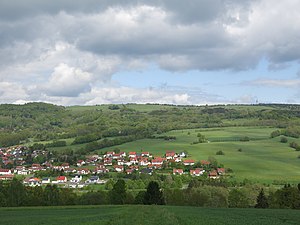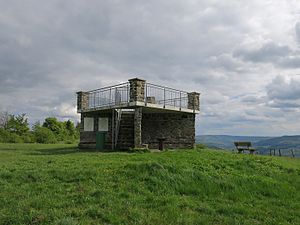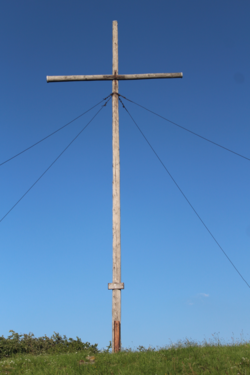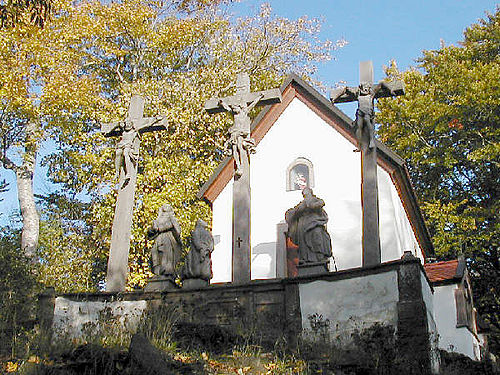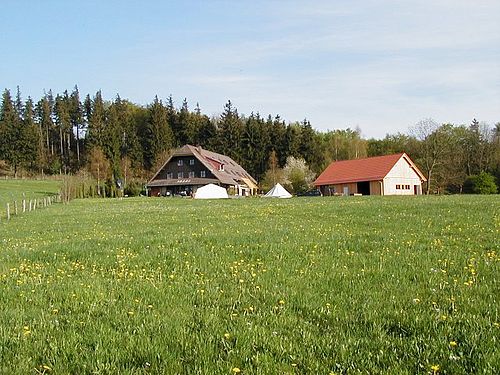Book screen
| Book screen | ||
|---|---|---|
|
Book screen from the west |
||
| height | 745.2 m above sea level NHN | |
| location | near Hilders , Fulda district , Hesse , Germany | |
| Mountains | Rhön | |
| Coordinates | 50 ° 34 '26 " N , 10 ° 1' 48" E | |
|
|
||
| particularities | Observation tower , cross of the east, telecommunications tower | |
|
The lookout point on the book screen |
||
The book screen (or book screen mountain ) is 745.2 m above sea level. NHN high mountain in the Rhön east of Hilders in the Hessian district of Fulda . It is located both in the Rhön Biosphere Reserve and in the Hessian Rhön Nature Park . On the summit there is a lookout point, which allows a wide view in western and northern directions as well as into the Ulstertal . This makes the book screen a popular destination for hikers. On the summit there is also a memorial stone for the Rhön Club , Hilders branch, the Cross of the East and, further south, a telecommunications tower.
On the south-western slope lies the basalt rock group of the Battenstein with a chapel, in the west a holiday home area and the youth campground of the Hilders community, as well as a youth hostel . In the northwest are the youth education and leisure centers Thomas-More-Haus and Pater-Löslein-Hütte of the St. Michael youth organization . In the north there is the sea cowl , a resting point of the Rhönklub branch club Simmershausen / Rhön. The Rhönwald trail in the southeast is a popular destination for winter sports enthusiasts.
The Battenstein
The name of the 629 m high basalt rock group of the Battenstein on the south-western slope of the Buchschirm and the field name Betteldasche seems to be of Celtic origin, a byway of the local path , an old trade route , led through this area .
The chapel
The pilgrimage chapel of St. Maria was built in 1706 under Johann Jakob Hartmann, who was born in Hilders (pastor in Hilders from February 22, 1700 to February 11, 1742). Above the lintel is a glazed wall niche with a late Gothic statue of the painful Mother of God from 1851. Inside there is a small baroque altar and various representations of saints. At the beginning of the 1970s, the main Baroque figure of the little church, an Immaculata (Immaculate Conception) and a “enthroned Madonna” (inside above the door) fell victim to a shameful theft. At the end of 1993, when the baroque altar was dismantled, a number of wooden crutches came to light. Did people with foot sickness beg for and experience healing here?
The Way of the Cross
The way of the cross to the Battenstein chapel was started under Hartmann's successor Johannes Bernardus Stapf from Mellrichstadt , (pastor in Hilders from April 2nd, 1742 to May 7th, 1762). Due to the Seven Years' War (1756–1763), the houses of the Stations of the Cross were built in six years of construction (1755–1761), in which some old sculptures (remains of a wayside shrine and tombstone) were walled in.
Under the following pastor Anton Johann Nikolaus Rehm from Fladungen , (pastor in Hilders from June 4, 1762 to February 1776), the Stations of the Cross were designed. Because of the need, Hilders families formed so-called "friendships". These working and support groups each designed and financed a station with a wood carving.
The Kolping Family Hilders has been committed to the preservation of this cultural asset for many years. In the years 2009–2013, all stations of the cross were completely renovated. Most of the funding came from private donations, but public funds from the municipality, the district, the Fulda diocese and the Fulda Sparkasse Foundation also participated. The largest share in the successful renovation, however, have the volunteers, who have worked countless hours. In June 2013, the 11 completely redesigned Stations of the Cross were opened to the public as part of the 100th anniversary of the Kolping Hilders family.
The poor soul house
It stands on the slope to the left of the Battenstein Chapel and was created as a foundation by two journeymen masons in 1827 as part of renovation work under the Hilders pastor Adam Krampfert from Randersacker , (pastor in Hilders from February 1825 to August 1830). Inside there is a stone relief, which is likely to be considerably older. It depicts how redeemed souls are taken out of the fire by angels and how guilty souls get into the fire blight. At the bottom left in the fire is the figure of a Pope. This seems to be based on the legend that Pope Innocent the Great must remain in purgatory until the end of the world.
The crucifixion group
The Battenstein in its current form was completed around 1760 by the crucifixion group in front of the chapel, which was renewed in 1836 under Pastor Balthasar Wolpert from Würzburg (pastor in Hilders from May 1835 to July 1845).
Catholic youth education and leisure centers
The book umbrella is of particular importance and is well known beyond the region through Catholic camps for children and young people in the diocese of Fulda .
The history of Catholic camps on the book screen
From 1958, Capuchin Father Archangelus Löslein (born November 3, 1903 in Alzey ; † February 13, 1982 ) was released from work in the diocese of Fulda, especially for church youth work. In this role, Father Löslein organized the first tent camps for boys on a meadow near the Battenstein. The tent camps, organized by the Catholic Young Community (KjG) in the diocese of Fulda, used the youth camp site of the Hilders community until 1978. Every summer there were 3 - 4 tent camps for up to 80 children each. After the Jugendwerk St. Michael acquired the site and the shell of a planned stud in the north-west of the Buchschirm, these diocesan camps have been offered by the Catholic young community in the diocese of Fulda since 1979 on the Thomas More campground.
The Thomas-More-House with a campsite
The Thomas-More-House on the high plateau of the Buchschirm is a house for education, leisure and meeting in the diocese of Fulda. Attached is a 17,000 m² campsite with a play barn, one of the largest campsites in the region. In addition to youth groups, associations and school classes, it also offers family groups, adult associations and parish groups an ideal venue for educational and leisure activities. The sponsor is the non-profit youth organization St. Michael.
The Pater-Löslein-Hut with a campsite
The Pater-Löslein-Hütte , a self-catering hut near the Thomas-More-House, is used to supply a separate 8,000 m² campsite, which can be used from May to October. Groups of children and young people from all over Germany and regional clubs like to use the hut and the campground. The non-profit youth organization St. Michael is also responsible.
gallery
See also
swell
literature
- Michael Mott : Destination of countless petitioners / Christian gem over the Ulstertal: The pilgrimage church on the Battenstein is in need of renovation, in: Fuldaer Zeitung, March 3, 1994, p. 20 (series: DENK-mal!).
- 1075 years Hilders and Simmershausen, review of the local history in individual contributions. Publishing house Parzeller GmbH & Co KG, Fulda; ISBN 3-7900-0195-3
Web links
- Internet presences from the Thomas-More-Haus , the Pater-Löslein Hütte and the Jugendwerk St. Michael eV
- Panorama photo from the viewing point on the book screen (labeling of visual targets can be activated), on panorama-photo.net
